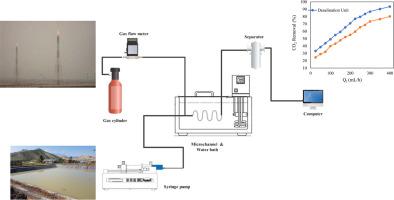Carbon dioxide removal from flue gas of oil production companies using wastewater in microchannel
IF 3.9
3区 工程技术
Q3 ENERGY & FUELS
Chemical Engineering and Processing - Process Intensification
Pub Date : 2025-09-11
DOI:10.1016/j.cep.2025.110552
引用次数: 0
Abstract
In this article, the chemical absorption of carbon dioxide is performed using desalination and caustic wastewaters in a T-shaped microchannel. To achieve this, the influence of temperature, gas flow rate, and liquid flow rate was investigated. The experimental results demonstrated that operating parameters significantly affect the efficiency of carbon dioxide removal. For example, an increase in gas flow rate leads to a substantial decrease in CO2 removal efficiency. In optimal conditions, the maximum CO2 removal coefficient obtained by desalination and caustic wastewater is 93.6 ± 4.7 % and 80.2 ± 4.0 %, respectively. Considering that the chemical absorption of carbon dioxide was carried out on both caustic and desalination effluents, the absorption of carbon dioxide in the desalination effluent was more than the caustic effluent and showed a better performance.

利用微通道废水去除采油企业烟气中的二氧化碳
在本文中,利用海水淡化和苛性废水在t型微通道中进行二氧化碳的化学吸收。为了实现这一目标,研究了温度、气体流速和液体流速的影响。实验结果表明,操作参数对co2脱除效率有显著影响。例如,气体流速的增加会导致CO2去除效率的大幅下降。在最佳条件下,脱盐和碱废水的最大CO2去除率分别为93.6±4.7%和80.2±4.0%。考虑到对碱化出水和脱盐出水都进行了二氧化碳的化学吸收,脱盐出水对二氧化碳的吸收量大于碱化出水,表现出更好的性能。
本文章由计算机程序翻译,如有差异,请以英文原文为准。
求助全文
约1分钟内获得全文
求助全文
来源期刊
CiteScore
7.80
自引率
9.30%
发文量
408
审稿时长
49 days
期刊介绍:
Chemical Engineering and Processing: Process Intensification is intended for practicing researchers in industry and academia, working in the field of Process Engineering and related to the subject of Process Intensification.Articles published in the Journal demonstrate how novel discoveries, developments and theories in the field of Process Engineering and in particular Process Intensification may be used for analysis and design of innovative equipment and processing methods with substantially improved sustainability, efficiency and environmental performance.

 求助内容:
求助内容: 应助结果提醒方式:
应助结果提醒方式:


